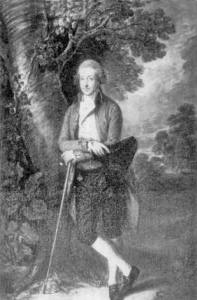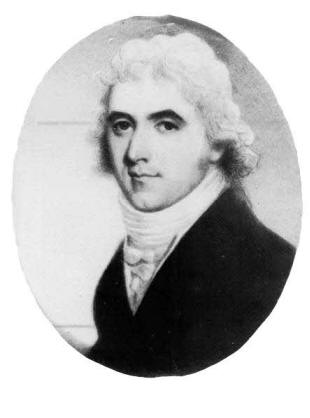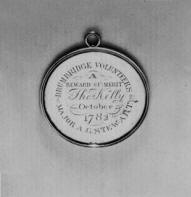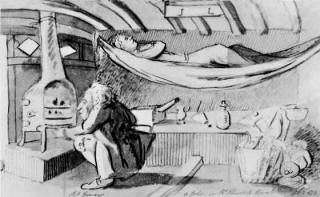
- Front Page
- Foreword
- Acknowledgements
- Obituary
- Lisburn Bus Services In The 1920S & 30s
- A Glimpse Of Drumbeg, 1750-1800
- The Lisburn Area in The Early Christian Period.
- Childhood Memories Of Mona Mckeown(1904-985) Of Glenavy
- Bishop Jeremy Taylor's Funeral Hatchment
- Black Abbey, The Archbishops Of Armagh And The Church Of Derryaghy
- Edward Smyth, M. P. For Lisburn 1740-60: His Token
- The Establishment And Early Day Of Technical Education In Lisburn, 1901-1920
- Bygone Days
- The Arrival Of Paddy The Piper, By Samuel Mccloy:
- Book Reviews
- Historical Journals
A GLIMPSE OF DRUMBEG, 1750-1800
EILEEN BLACK
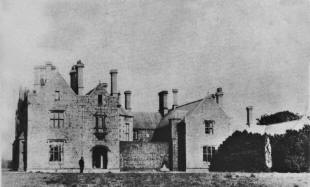 The steady growth and development of Belfast during the
past forty years or so has resulted in numerous small villages on the city's
outskirts - places like Dunmurry, Carryduff and Newtownbreda being subsumed into
greater Belfast, sadly to the loss of their local character and uniqueness.
Drumbeg, now little more than an extension of the Upper Malone Road, has
regrettably not escaped this encroachment. Since the late Fifties and early
Sixties, housing development on the Ballyskeagh and Drumbeg Roads has gradually
whittled away the country feeling and rural atmosphere of this peaceful and
quiet spot, whose most distinguishing features, to many people, are its
picturesque church and lynch gate, close by the Lagan. Soon, in fact, the area's
rural past will have completely faded from living memory.
The steady growth and development of Belfast during the
past forty years or so has resulted in numerous small villages on the city's
outskirts - places like Dunmurry, Carryduff and Newtownbreda being subsumed into
greater Belfast, sadly to the loss of their local character and uniqueness.
Drumbeg, now little more than an extension of the Upper Malone Road, has
regrettably not escaped this encroachment. Since the late Fifties and early
Sixties, housing development on the Ballyskeagh and Drumbeg Roads has gradually
whittled away the country feeling and rural atmosphere of this peaceful and
quiet spot, whose most distinguishing features, to many people, are its
picturesque church and lynch gate, close by the Lagan. Soon, in fact, the area's
rural past will have completely faded from living memory.
Fortunately, there are a number of eighteenth and nineteenth century accounts of the district which enable us to picture what the area was like in days gone by. Arthur Young, writer and agriculturalist, who travelled from Lisburn to Belfast in 1779, noted twelve or thirteen bleachgreens on the banks of the Lagan between the two towns and commented upon the large quantities of flax growing in the fields.1 (By then, the lower Lagan Valley was reckoned to be making one third of the £800,000 per annum which counties Antrim and Down produced by the linen industry). A number of travellers between Lisburn and Belfast thought the area resembled an English district - by which they meant pretty, neat and well cultivated! J. Gamble, on a harvest evening in 1812, while walking from Lisburn to Belfast, was struck by the advanced and distinctive character of the district. `I felt more forcibly I was in the neighbourhood of a great town. Had it not been for the lofty range of mountains on my left hand.. I should have thought myself in the environs of London. The country was in the highest state of cultivation- it looked like one continued garden, shadowed with trees, interspersed with thickets, and neat white-washed houses.2
One's neighbours were not far off, on this particular stretch of road. Dubourdieu, in 1811, likened the area to `a village, the houses, except where a gentleman's place intervenes, being within call of each other." The district near Drumbridge was dominated by three demesnes situated in close proximity to each other: Wilmont and Ballydrain, seats of the Stewart family and Drum House, home of the Maxwells. (Both Stewart estates have been studied in some detail by the author, in previous volumes of this Journal.4
 |
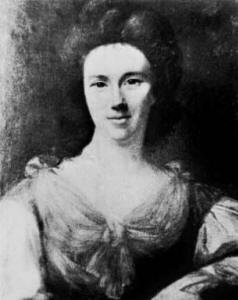 |
| Fig. 1. William Stewart (1733-1808) of Wilmont. (Photograph courtesy of W.R.H. Charley). | Fig. 2. Anne Stewart (née Garner), second wife of William Stewart. (Photograph courtesy of W.R.H. Charley). |
Wilmont (now Dixon Park), where William Stewart (fig.1) built his family seat about 1765, was an extensive farm, with a sizeable bleachgreen. Like many of the gentry in the district, William was also a merchant of some standing, with numerous interests including a partnership in the Newry Flour Mill Company5 and shares in the Belfast Discount Company. The Belfast News-Letter of 4 March 1766 records him selling Bristol Crown glass, Welsh slates, lignum-vitae6 and various kinds of forest trees from premises at Drumbridge (possibly from the bleach house he had there) .7 Like his brother Robert at Ballydrain, William had a large family, thirteen children by his second wife, Anne Garner (fig. 2) (his first wife, Elizabeth Harvey, died in 1767). After William's death on 10 March 1808, his eldest son John (fig. 3) succeeded to the estate.
Ballydrain (now Malone Golf Club), seat of Robert Stewart (1749-97) had a bleachgreen and flax mill by the banks of the Lagan.8 Besides his linen interests, Robert farmed and was also involved in a number of mercantile ventures, being a member of Belfast Chamber of Commerce and a shareholder in the Belfast Discount Company. He maintained at least one boat on the Lagan Canal, the Hillsborough Trader, which plied thrice weekly between Belfast and Lisburn (with goods carried overland from Lisburn to Hillsborough) during 1775, and probably thereafter.9 An illustration (fig. 4) of the interior of a boat belonging to him - is it perhaps the Hillsborough Trader? - by artist John Nixon, is in the Ulster Museum. Though very crudely painted, especially in the ape-like figure of the man crouching by the stove, the painting is a valuable piece of local history and a useful addition to Stewart memorabilia. Robert, in fact, also sailed as a pastime. The Belfast News-Letter of 20-24 July 1781 carries a notice advertising the sale of his pleasure boat, a cutter rigged vessel of seventeen tons, about five years old, 'very fast, ]with] a very large excellent cabin with everything ready for the sea.' He kept the vessel moored at Whitehouse, possibly at Macedon, home of his brother Alexander George.
Although Alexander George (1737-94)10 had built Macedon, he appears to have preferred to live at Windsor, in Ballydrain grounds, with his sister Elinor. He too was a merchant and is recorded as selling lignum-vitae from Ballydrain in 177111 and powder blue for bleachers.12 All three brothers William, Robert and Alexander George, in partnership with Robert Thomson, bought the Old Sugar-House, in Rosemary Lane, Belfast, in February 1777, and traded under the name of Stewart and Thomson13 until 1793, in which year they sold out to Messrs. Francis Jordan and Co.14 From these various activities, it can be seen that the Stewart family's influence on the area around Drumbeg, combined with their mercantile ventures in Belfast, was considerable, and must have given employment to many.
The Maxwell family of Drum House were likewise involved in linen and had been so from an early date, Hamilton Maxwell having introduced water-beetling machinery for finishing linen at Drumbridge in 1727.15 After his death in 1751,16 the estate remained in the Maxwell family's possession, certainly up until 1812 and probably later. 17 This land, too, was farmed and had a sizeable plantation.
Such, then, were the estates and the principle families
around Drumbridge in the late eighteenth century
![]()
Although Gamble's aforementioned description of the area makes it sound almost paradisial - a pastoral scene of abundant vegetation, rolling distant hills and pretty white-washed houses-the area was not free from the darker side of life such as crime of various kinds. In May 1768, about forty feet of stone coping disappeared from the top of Drumbridge and about thirty feet was also taken `off a Bridge over the Navigation below.18 A reward of five pounds for information as to the culprits was offered by John Stewart of Ballydrain). On 11 January 1783, a store at Four Lane Ends, belonging to the curate of Drumbeg and Drumbo, the Rev. William Lindsay, was broken into and a quantity of his pickled beef, meal and various sundries taken.19 (Four Lane Ends was a crossroads at Dunmurry Lane, formed by a road opposite to it, which ran along the side of the Ballydrain Estate).
The gentry and their fine houses were also not immune to the depredations of the burglar. On 11 December 1800, Windsor, Elinor Stewart's home in Ballydrain grounds, was broken into by three masked men who made off with £175 in cash, together with a number of tea spoons and a watch 20 This robbery appears to have created a considerable stir in the district, judging from the fact that twenty-seven members of leading families in the area, including John McCance, John Charley, Andrew Durham and William Hunter, clubbed together and offered a reward of 475 guineas for information which would lead to conviction of the criminals.
Theft from bleachgreens was a common occurrence and Robert and William Stewart both lost linen on occasion 21 Various means were employed by green owners to protect their cloth at night: armed guards were used, for instance, and dogs `of a particular breed ... little less formidable than tygers.'22 The death penalty, imposed in 1763, did little to alleviate the problem. In 1797, an act of the Irish parliament empowered J.P.s to issue search warrants for cloth stolen from bleachgreens and to impose fines or imprisonment on the culprits - a much more sensible solution, given that such thefts were sometimes for very small amounts.
Punishment for serious crimes was occasionally carried out in public, to set an example and act as a deterrent. Drumbeg witnessed a number of such spectacles in the late eighteenth century. At the end of July 1784, a female member of a gang of night thieves was publicly whipped from Lisburn to Drumbridge for committing several thefts between Lambeg and Drumbridge on the evening of 26 July. The sentence `was executed amidst a great concourse of people; and it is much to the credit of the gentlemen in the neighborhood who attended, that the punishment was inflicted with the least disorder.' Needless to say, it was hoped that `such an exemplary punishment as has been inflicted on this wretch (and of late on the villains that have attempted to rob the bleachgreen of Mr. William Stewart of Wilmont) will be a means of preventing in future such audacious rogues from such practices in that neighbourhood.'23
Seasoned thieves who stole from bleachgreens usually received more than a whipping, however certainly after the imposition of the death penalty in 1763. In view of the fact that there were so many greens in the area, it seems hardly surprising that there was a gallows at Drumbridge. Here, on 17 April 1783, one Patrick Gordon, otherwise McGurnaghan, was executed for stealing linen, having been sentenced at the Down Assizes.24 In the spirit of penitence (and perhaps in the hope of leniency), he divulged to the authorities, on his journey from Downpatrick jail to the place of execution, `some very useful discoveries upon knots of rogues, who have carried on the practice of stealing linen.' Although not reported in the newspapers, there were in all likelihood large numbers of people watching the event.
Notwithstanding the fact that life had its harsh side, the spirit of philanthropy waxed large in the district, certainly as regards the children of the poor. In October 1765, the Earl of Donegal (fig. 5) gave ten guineas for the building of a school for the children of his poor tenants at Four Lane Ends near Drum (opposite Ballydrain and not far from the corner of Dunmurry Lane, where there was a crossroads; see D835/1/3/19, PRONI), and endowed it with an annual grant of £10.25 This gesture was in response to a plea by `the poor Inhabitants about the Lane-Ends, sensible of the Disadvantages they laboured under by their not being able to encourage a School-master, properly qualified, to instruct their children, and reside among them, took the Liberty of representing their unhappy and distressed Situation to ... the Earl of Donegal.' 26 The Earl's benevolence, in fact, had a knock-on effect, for the Countess of Donegal27 donated the same amount as her husband and a number of local gentry, including the three Stewart brothers already mentioned and Mrs. Maxwell of Drum, also contributed. By 1768, over £72 had been raised by subscriptions. The school house, thirty-six feet long, was sufficiently large to accommodate twenty poor children, of both sexes.
The Chichester School, as it was called, flourished for a
number of years, certainly up until 1775, and was well supported in the locality
by donations and collections raised from charity sermons preached at Drumbeg and
Dunmurry. 28 Assemblies - genteel social gatherings featuring supper,
card games and perhaps a little dancing-were held regularly in the school during
1774 and 1775, always on the night of a full moon, to facilitate travelling.
Money raised from the sale of tickets to these events, also helped maintain the
institution.29
![]()
The school's main object was 'to instruct the Children of the Poor in the Knowledge of the Christian Religion; as well as Reading, Writing and Arithematick.'30 All the children were fitted out with uniforms, each boy (of whom there were sixteen in 1771) being given `a coat, a waistcoat, and a pair of breeches, two pairs of stockings, one pair of shoes, two shirts and a hat.' The girls (there were four in 1771) were each supplied with `a gown, pettycoats, two shifts, two pairs of stockings, one pair of shoes, two caps, two bibs and aprons.31 In keeping with the emphasis on religious instruction, each child was given a New Testament and a Whole Duty of Man. Undoubtedly, the school was of considerable benefit to the children of the poor in the Drumbeg area, who may not otherwise have had the chance to acquire even the rudiments of learning.
The district was quite politically conscious, with Volunteering well to the fore. The Volunteers 32 had been formed in Belfast in March 1778, in response to the government's inability to provide even a rudimentary militia for the defence of Ireland, during the American War of Independence (the bulk of Ireland's soldiery having been sent overseas). France had joined with America to fight the British and Ireland was in an extremely vulnerable position-so Belfast's citizens founded their own `army'. After the establishment of the Belfast 1st Volunteers, numerous other companies were set up in various parts of the country. Besides being a large and powerful military force-about 80,000 to 90,000 officers and men by 1781 - the Volunteers espoused two political causes: parliamentary reform and legislative independence for the Irish parliament.
The latter was granted in 1782. The former, however, the
Volunteers never saw realized. In 1793, they were suppressed by the government.
Their internal structure-- radical in that it smacked of social equality
(officers were elected) and dangerous democratic leanings (many
Volunteers were fired by the ideals of the French Revolution) - had worried the
government for some time. Their continued existence in the early days of the
United Irishmen, when they were a redundant yet possibly still effective
military force, was a situation which the government felt threatened by - hence
their suppression.
Drumbridge
had its own Volunteer company (fig. 6), founded on 12 September 1779, under the
command of Major Alexander George Stewart of Ballydrain. The company played an
energetic role in Volunteer activities and was present at the major Belfast
Reviews of July 1780,'81, '82, '84 and '85 and at Broughshane in July 1783, as
well as at various local reviews, such as Lisburn in March 1781. 33
Alexander George appears to have been highly thought of as a commander and
organiser and nerved in the Committee established to assist the Exercising
Officer of the Belfast Review of 1781.34 He subsequently served as
Quarter-Master General of the Belfast Reviews of 1784 and '85 35
The standing of the Drumbridge Volunteers in the area around Dunmurry, Ballylesson and Lisburn was high, doubtless because of Alexander George's leadership. Under his able direction, the company in fact staged their own Review, on Saturday 4 November 1780, in the grounds of Drum House, Miss Maxwell having lent her estate for the occasion.36 The event, watched by a large number of spectators, commenced at noon with the firing of a cannon. After the various salutes, firings and evolutions had been carried out, the troops began a mock engagement, having been divided into two groups, those who wore red uniforms and those who wore blue.
`The two battalions having separated, marched to their respective parades, the first to the North side of the water, the other continuing on the South Side. The first [blue uniforms] consisted of the Lambeg Volunteers, Capt. Bell; Lisburn Blues, Capt. Burden and Dunmurry Volunteers, Capt. Johnson. [These latter wore red but joined the blues, to even up the numbers. The second [red uniforms] contained Drawbridge Volunteers, Lieut. Mitchel, (Capt. Stewart 37 acting as director of the mock engagement); Purdysburn Volunteers, Capt. Willson; Ballylesson Royals, Capt. McNeill; and Lisburn Fuziliers, Capt. Jones. In the mock engagement. the blue battalion were to force their way over the water from the North side; the scarlet battalion were to oppose their passage, and in case of defeat, to effect a regular and secure retreat ...'38
The engagement went off very well, `the officers behaved like men perfectly masters of their duty; and the men manifested a prompt, implicit obedience, the natural result of discipline, and the sure forerunner of victory and honour. They performed the whole of [the] day's service (including their march from their respective cannonments), without indulging themselves with any refreshment. The weather was favourable, the spectators were delighted, and the troops returned to their quarters in a regular and peaceful manner.'39 The following week, the company publicly thanked Miss Maxwell for the generous use of her grounds, through the medium of the Belfast News-Letter.40
The strength of the Volunteers in the district indicates that, in all probability, the cause of parliamentary reform was well aired in the locality. Certainly, William and Robert Stewart, like their Volunteer brother, Alexander George, appear to have had some sympathy for one particular aspect of it, namely electoral independency from the extremely powerful influence of the Hill family,41 who had been granted the earldom of Hillsborough. By 1783, Co. Down elections had come to be dominated by the Hills and the Stewarts of Mount Stewart, with both county seats being held - usually - by members of these two families or their nominees42 . This system had come under considerable criticism by the Volunteers, who wished to see a loosening of the hold of the great landed proprietors upon the county constituencies, a more adequate representation of the minor gentry in parliament, and a greater cognizance given to the electorate's wishes.
In the Co. Down general elections of 1770 and 1776, the
Hill and Stewart families had worked together, with the Rt. Hon. Robert Stewart,
later 1st Marquess of Londonderry, being elected with the support of the
Hillsborough interest. The 1783 election, however, saw a clash between these two
leading families. Three contestants vied for the two seats: Lord Hillsborough's
son, Lord Kilwarlin, Lord Bangor's son, Edward Ward, as an independent, and the
above-mentioned Rt. Hon. Robert Stewart. Stewart was a popular choice with the
local Volunteer companies and many of the smaller gentry and landlords of the
county (the independents), who saw him as a supporter of a more open electoral
system.
![]()
Polling commenced on 14 August and ended on 5 September, with Kilwarlin and Ward winning the two seats, the latter (supposed to be an independent) joining forces with Kilwarlin on 1 September, to avoid defeat. During early October, a number of smaller gentry of the county, including Rainey Maxwell of Drumbo, and William and Robert Stewart (of Wilmont and Ballydrain) -those who were of the independent interest - raised meetings in Ballynahinch, to protest about the handling of the election. a On 16 October, the defeated Stewart and a number of the Co. Down independents, led by Maxwell, presented petitions to the Irish House of Commons, complaining that the Sheriff had shown partiality to Kilwarlin and Ward, and had closed the poll too abruptly, thereby depriving Stewart of a considerable number of votes, which cost him the election.44 The petitions, considered by a Select Committee in early November, met with no success. 45
The fact that both Stewart brothers were involved in the petitions sheds an interesting light on them and their attitude to change. While not radicals, they undoubtedly wanted a greater say in the running and direction of the country, through M.P.s from a different rank of society to the Hillsborough family. William Stewart, in fact, seems to have retained his interest in parliamentary reform for the rest of his life, being Chairman of a meeting of the parishioners of Drumbeg, held in Drumbeg Church on 2 January 1793,46 to select delegates to send to the Ulster Reform Convention in Dungannon the following month. (His son, John Stewart, fig. 3, was one of the two representatives of the parish chosen to attend.)
This reform movement47 of the early 1790s; saw new Volunteer corps being set up in various parts of the country and numerous reviews being held, to gather support for reform. The major aims of the reformers, an extension of the franchise and a rationalisation of constituencies, in fact appealed to a wide section of Ulster society, which otherwise was probably quite conservative in outlook. Running parallel to it, was the much more radical reform demand of the United Irishmen, who wished to see Ireland a republic, independent of Britain. William Stewart, by contrast, and those of his ilk who attended the Ulster Reform Convention, disapproved of republicanism, were attached to the Constitution, but did want moderate reform, including Roman Catholic enfranchisement. In the event, the Volunteers were suppressed in March 1793 and the reform movement subsequently vigorously repressed by the government.
The area saw two important alterations to the landscape during the period featured in this article: the formation of the Lagan canal48 and the rebuilding of Drum Church. During the eighteenth century, Lough Neagh became the centre of a network of canals which served a large area of Ulster: the Newry Canal, Ducart's Canal, the Coalisland Canal and the Lagan Navigation. The Belfast-Lisburn section of the latter, started early in 1756, had reached Drumbridge by the end of that year and was finished by September 1763, when the Lord Hertford, a barge owned by James Gregg, made the first trip along it. The occasion was one of much merry-making and rejoicing, Gregg hosting a party on board, where `Food of all descriptions was provided and 12 varieties of wine were served. As the boat sailed along past bleach greens and fields where corn was being cut, a band aboard played popular airs. Hundreds of people stood on the banks and walked along the towpath as far as Lisburn.49 Lisburn itself was illuminated, with bonfires in the streets, free ale and dancing, in celebration of the opening of this important new link with Belfast. Doubtless there was considerable excitement around Drumbridge, as the laden and noisy boat sailed slowly by, en route to Lisburn.
The end of the century- 1798-saw the rebuilding of Drum Church.50 The site had been used for worship since mediaeval times, though the original building had probably been about twenty yards south east of the present Church. The 1798 church was paid for by subscriptions and a donation of £461 from the Board of First Fruits. Part of this late eighteenth century structure still remains, incorporated into Sir Thomas Drew's rebuilding of 1870. The handsome new church, complete with wooden spire, must have beep a striking and graceful addition to the neighbourhood.
Driving along past Dixon Park (Wilmont) and Malone Golf
Club (Ballydrain) and round by the church, it is difficult to picture the area
as described in this article: to see the children of the Chichester School
filing into class, the dead body of Patrick Gordon swinging at the gallows at
Drumbridge or the flash of the red and blue uniforms of the Volunteers,
as they held their mock engagement in Miss
Maxwell's grounds at Drum House. It is not easy to visualize this green and
pleasant suburb as having had so much life in its midst-the Assemblies at the
School, the barge traffic along the Lagan, the industry in the fields and
bleachgreens. Nevertheless, this glimpse of Drumbeg, culled largely from
newspaper columns, is as it was then ... so many years ago.
![]()
References
| 1. | Arthur Young. A tour in Ireland, 1780. Also Constantia Maxwell, ed., Arthur Young A Tour in Ireland, 1925. There were, in fact, twelve bleachgreens between Lisburn and Belfast, according to J. Lendrick's map of county Antrim, 1780. |
| 2. | E.R.R. Green. The Lagan Valley 1800-1850. 1949, p.32. |
| 3. | Ibid., p. 159. |
| 4. | 'Wilmont, Dunmurry: A profile,' vol. 4, December 1982;'Ballydrain, Dunmurry -An Estate Through the Ages; vol. 5, December 1984; `Mr. Stewart's Ballroom Near Lisburn: Further Reflections on Ballydrain,' vol. 6, Winter 1986-87. |
| 5. | Belfast News-Letter. 20 October 809. |
| 6. | Hard heavy wood from a family of tropical American evergreen trees. |
| 7. | Belfast News-Letter, 8 November 1765. |
| 8. | Shown on Robert Whitworth's plan of the Lagan navigation, 1768. Sec p. 108 of May Blair, Once upon the Lagan, 1981. |
| 9. | Belfast News-Letter, 2-6 June 1775. |
| 10. | My article 'Ballydrain, Dunmurry - An Estate Through the Ages; gave his death as 1796. The Belfast News-Letter of 10-14 January 1794 records that he died on 3 January inst. |
| 11. | Belfast News-Letter. 5 February 1771 |
| 12. | Ibid ,20 March 1761, |
| 13. | Ibid- I5-18 April 1777. |
| 14. | Ibid., 5-8 February 1793. |
| 15. | Green, op it., p 69. |
| 16. | Fred Heatley's notes in the Linenhall library reprint of Proctor's Belfast Scenery, 1983. |
| 17. | Miss Letitia Maxwell is known to have been in occupation of the estate between 7774 and 1812 (Belfast News-letter, 8-I I November 1774; ibid., 20 October 1812). |
| 18. | Belfast News-Letter. 10 May 1768. |
| 19. | Ibid.. 17-21 January 1783. |
| 20. | Ibid, I6 December 18110, |
| 21. | Ibid., 8 ctrl 15 November 1765; 9-12 June 1778. |
| 22. | Green op. cit,, p As |
| 23. | Belfast News-Letter 27-30 July 1784. |
| 24. | Ibid, 8-Il April 1783, 22-25 April 1783. |
| 25. | Ibid, 15 October 1765. |
| 26. | Ibid , 30 September 1768. |
| 27. | A portrait of the Countess of Donegal (1738-80), by Francis Cotes, is in the collection of the National Gallery of Ireland, |
| 28. | For example, at Dunmurry in January 1771 (Belfast News Letter, 18 January 1771) and at Drumbeg in July 1775 (Belfast News-Letter, 25-28 July 1775). |
| 29. | Belfast News-Letter 11-14 October and 11-15 November 1774; 610 January, 7-10 March, 26-30 May and 28 July -1 August 1775. |
| 30. | Ibid, 7-10 March 1775. |
| 31. | Ibid, 12 April 1771. |
| 32. | For an interesting and detailed account or the Volunteers, see Peter Smyth's The Volunteers, 1778-84, (PRONI) and his article. 'The Volunteers of 1782', in An Cosantoir, April 1976. See also Thomas MacNevin, The History of the Volunteers of 1782, 1845. |
| 33. | Belfast News-Letter 14-18 July 1780, 13-16 March and 24-77 July 1781, I5-18 July 1783, 9-13 July 1784 and12-15 July 1785. |
| 34. | Ibid., l6-20 March 1781 |
| 35. | bid- I5-I8 March 1785. |
| 36. | The event is reported at some length in the Belfast News-Letter, 10-14 November 1780. |
| 37. | Alexander George Stewart was elected Major of the Sixth Ulster Regiment, to which the Drumbridge Volunteers belonged, in September 1781 (Belfast News Letter, 4-7 September 1781). |
| 38. | Belfast News-Letter, 10-14 November 1780. |
| 39. | Ibid |
| 40. | Ibid., 21-24 November 1780. |
| 41. | he Hill family owned about 100,000 acres in Co. Down in 1801, mostly in Upper and Lower Neagh and in Castlereagh; sec Peter Jupp, `County Down elections, 1783-1831,' Irish Historical Studies, vol. XVIII, 1972-3. |
| 42. | Jupp, loc. cit. |
| 43. | Belfast News-Letter, 3-7 October and 17-21 October 1783. Both William and Robert Stewart were on the Committee which raised the petition of electors to the Irish House of Commons, on 16 October |
| 44. | Both petitions are published in the Commons Journals of Ireland, 175317&5, vol. XI, pp. 19-23. |
| 45. | General index, to the Journals of the House of Commons, . vol. II, 1802. |
| 46. | Belfast News-Letter, l-4 January 1793. |
| 47. | For a useful account of the parliamentary reform movement in Ireland in the late eighteenth century, see R.B. McDowell's essays, `Parliamentary Independence 1782-9,' and `The Age of the United Irishmen: Reform and Reaction, 1789-94,' in T. W. Moody and W.E. Vaughan, eds., A New History of Ireland, vol. IV, 1986. |
| 48. | See May Blair, Once upon the Lagan, 1981. |
| 49. | Belfast News-Letter, 9 September 1763. Quoted in Blair, op. cit., p, 113. |
| 50. | See Samuel Lewis, A Topographical Dictionary of Ireland, 1847; R.S.J. Clarke, Gravestone Inscriptions, vol. 3, Co. Down 1969; Drumbeg Parish Magazine Centenary Issue, 1970. |
Eileen Black is an Assistant Keeper in the Art Department of the Ulster Museum. Her interest in Drumbeg stems from the fact that her mother's family, the Dugans, came from there. She would like to hear from anyone owning old photographs of the Drumbeg area.

